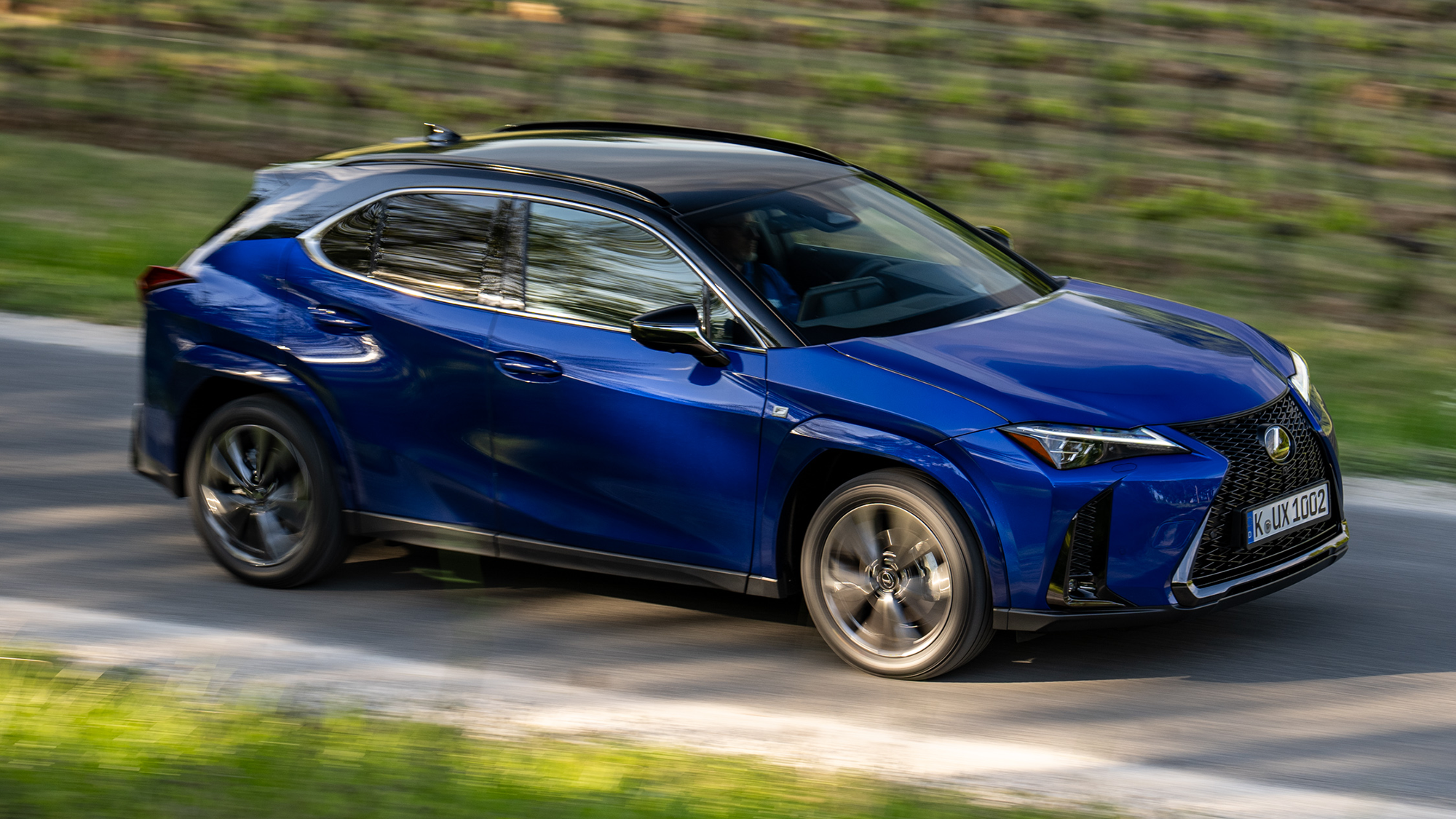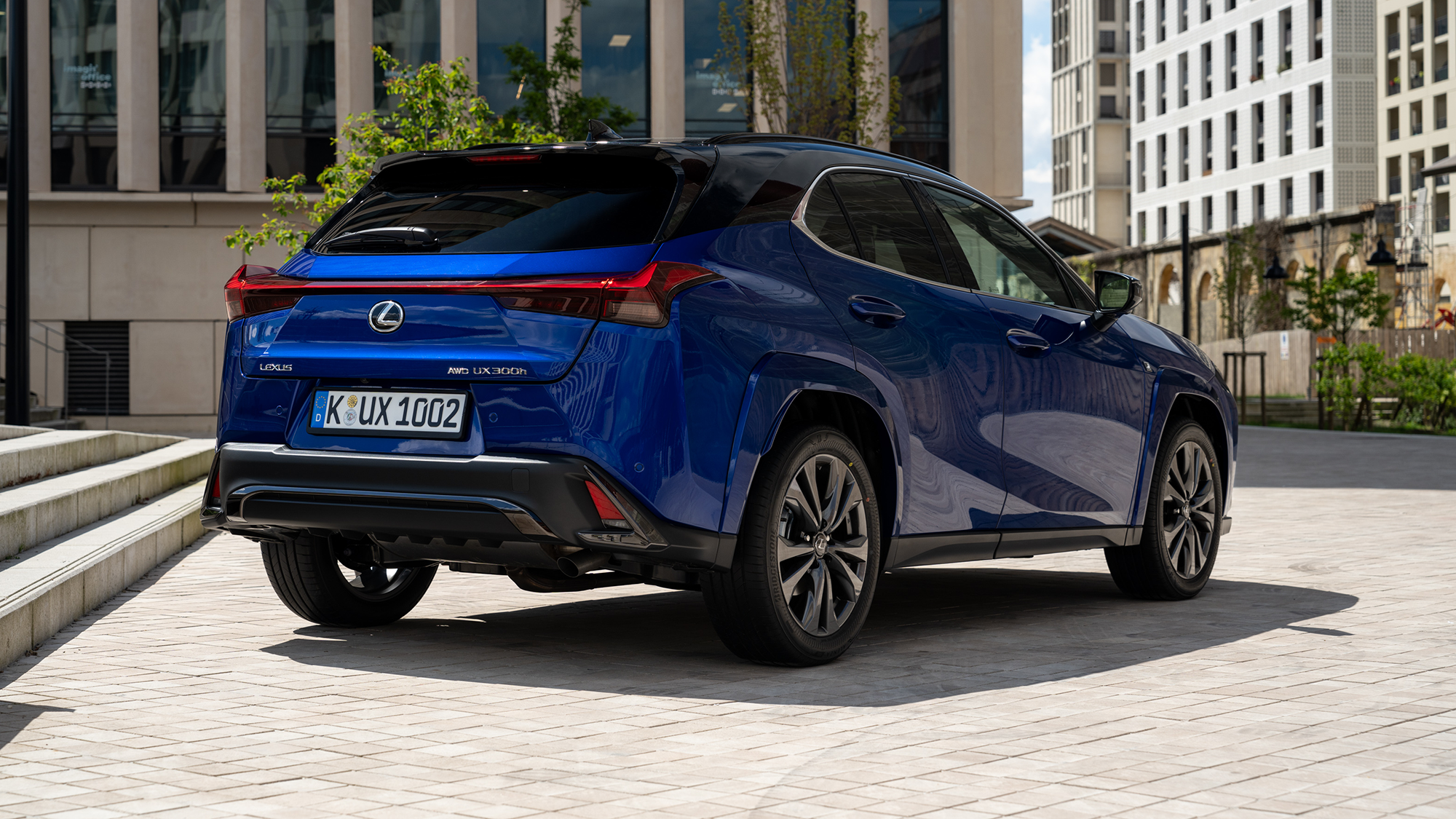► Upgraded Lexus SUV
► Efficient hybrid power
► Comfort over sportiness
Lexus has reshuffled its compact crossover SUV line-up this year, and in light of the LBX’s arrival, the bigger UX hybrid was due a revamp. No longer the 250h, the new UX 300h is faster and more efficient than the outgoing model – necessary updates to differentiate it from the smaller LBX and establish it as the more premium of the two models, according to Lexus.
At first glance, you could be forgiven for failing to notice the cosmetic changes. They’re negligible at best, but peruse the spec sheet or the performance numbers and suddenly the engineering team’s efforts become clear. The 300h has more power than the outgoing 250h, which translates to faster acceleration, among other uprated statistics. Will they be enough to compete with some very well-rounded competition in the small SUV class?
We’ve given both the two-wheel and four-wheel drive variants a go, so read on to find out our impressions of the new Lexus UX300h.
At a glance
Pros: Refined, comfortable, impressive performance
Cons: Dull interior, CVT can be tricky, strong alternatives
What’s new?
Lexus has revisited the performance capabilities of the UX hybrid with emphasis on the way it pulls when you put your foot down. The same two-litre four-cylinder engine has been carried over, but the 300 has been given an 8% total power increase over the 250 – up from 181bhp to 196bhp in the new model – thanks to a new 60-cell 222V lithium-ion battery.

Owners who tick the E-Four four-wheel drive system box will experience even faster acceleration by virtue of the 300’s new rear electric motor. It’s over five times more powerful than the outgoing 250’s equivalent, resulting in a 0-62mph time of 7.9 seconds compared to 8.7 seconds in the E-FOUR 250.
The front-wheel drive versions can’t quite match that, with an 8.1 second time, but it’s still a marked improvement. Lexus has also tightened up the way it drives with a support brace on the radiator, stiffening the 300’s body rigidity for a sportier drive.
The cabin has received a few touch-ups, including redesigned switches in the door panels and a slightly different instrument panel hood but again, the changes are minor. There is, however, a new 12.3-inch digital instrument cluster display that’s fully customisable, along with a raft of enhanced safety systems including a new Proactive Driving Assist feature to detect hazards at low speeds and react accordingly.
What about the interior?
The 300h’s interior will likely feel very familiar to 250h drivers. A lot of it hasn’t been touched, and so most of the previous cabin’s positive attributes have been transferred over, but still the new interior presents itself as a bit of a missed opportunity.

The cabin is refined and, for the most part, properly put together. The seats are supportive, comfortable, and highly adjustable in where you want them placed, but there’s no getting away from quite a high driving position.
The window control buttons in the driver’s-side door can be a bit of a stretch to reach from where you’re sat, while the cabin can feel quite subtly cramped. While headroom is plentiful and enough for six foot adults to enjoy, there isn’t an abundance of room in the back. Two fully grown adults won’t want to spend a long period of time in the rear seats unless absolutely necessary, but a couple of kids could easily get comfortable for a lengthy duration.
The materials used in the interior’s construction are of high quality, but the overall ambiance is very… business-like. In other words, rather tedious. It’s awash with drab colours and what seems like heavily restrained styling. It has the feel of a high-end utility vehicle like an Ineos product or a Land Rover Defender, though with very little in the way of actual off-road or other utilitarian capabilities to compensate.
Despite the large 12.3-inch screen, on which the graphics are pin-sharp and very reactive, the cockpit still looks about 10-years-old, helped in no small part by the chunky, characterless steering wheel before you.

It’s a shame, as with the rest of the upgrades, this could’ve been a good opportunity to get ahead of the UX’s strong competition with a freshly modernised cabin. There are still a handful of tactile buttons to control the car’s temperature and demister functions, so kudos for that.
How does it drive?
Not-so-small gripe about the interior over, the UX300h does redeem itself somewhat in the way it drives. In the car’s normal and eco modes, the steering is lightly weighted and direct. The brake pedal has a reassuring amount of resistance but it’s still easy to modulate, while the ride is as compliant as you’d expect from a Lexus. No one will find this a tricky machine to get to grips with, that’s for sure.
The 300h soaks up road imperfections with composure and dignity, and all the while in a hushed, unassuming tone from the 2.0-litre engine. Those in search of a family SUV that puts sportiness on the back burner for the sake of a quiet and refined driving experience will likely find a lot to savour in the way it trundles along.
Change into sport mode and the steering weights-up while the acceleration is sharpened.
Push the car in this mode and it’ll still hold itself together well with composure and little body roll. The uprated electric motor has the power to pull you out of corners with surprising proficiency at times, but still you’re met with an overriding sense that speed isn’t what the 300h was bred for.
With such a little to split the FWD and AWD versions in terms of acceleration, it’s unlikely you’ll be able to tell a difference day to day, but you may still want the extra push just to know it’s there.
The engine note wakes up with a crescendo when you put your foot down, but owing to Toyota’s favoured continuously variable transmission (CVT) gearbox that’s standard on all 300h models, the crescendo occasionally doesn’t know when to end.

On a few occasions, the transmission was reluctant to address the shrieking engine, especially when accelerating onto the motorway or other stretch open road, but for the most part it’s competent and useable transmission that most owners will have no problem with.
What about the specs?
The UX300h is available with just front-wheel drive or all-wheel drive courtesy of Lexus’ E-FOUR AWD system. Both versions are powered by a 2.0-litre, inline four-cylinder engine that produces 196bhp, while the E-Four AWD models have a 40bhp rear motor on the back axle. This translates to a faster 0-62mph time of 7.9 seconds – 0.8 seconds faster than the old model. With just a front-positioned electric motor to complement the ICE unit, FWD variants can do 0-62mph in 8.1 seconds. Both types use the same E-CVT gearbox and have a top speed that’s electronically capped at 110mph.
Kerb weight varies between the two: the FWD versions have a bottom-end weight of 1,540kg while the E-Four UX 300h weighs 1,600kg. The FWD 300h is also more fuel efficient, with a quoted WLTP mpg figure of 56.4. There’s not a lot in it, though, as the E-Four can still manage 50.4.
Trims and rivals
Prospective buyers have a lot of options to choose from when spec’ing up their cars. There are four basic trim grades, starting with the UX’s Urban trim for £34,895. For the money, you get a reversing camera, Lexus’ new fully digital instrument cluster and Apple CarPlay/Android Auto integration.

Above Urban, there’s the Premium trim line that introduces a heated steering wheel and driver monitoring among other additional features, then Premium Plus which includes the 12.3-inch infotainment display and leather upholstery. Again, among many other extras…
Above Premium Plus is the Takumi line trim, but then running parallel to these basic grades are the F-Sport alternatives. These trims furnish the car with slightly sportier styling options, on top of the tech provisions already offered by the basic levels. F Sport trims start from £37,495 in F Sport Design and max out with a range-topping F Sport Takumi AWD trim that cost £50,995.
Rivals are adept and aplenty in this fiercely competitive marketplace. The UX300h will have to fend off a particularly strong German offensive in the BMW X1, Audi Q2 and Q3 and the Mercedes GLA. These alternatives are similarly priced to the Lexus, and while weaker in some respects – ride in the Mercedes, for example – they have plusher cabins to suggest they’re better value for money.
Not only that, but the UX will also have to fend off a compact crossover from its own stable in the smaller but more modern LBX. Tough ask.
Lexus UX 300h verdict
A few grievances aside, this is still a likeable car. It rides beautifully and thanks to the power unit upgrades, you feel as though there’s a workhorse under its skin that has the strength to really push you along. The driving experience is a bit muted, but that’s not what this car is about.

No arguing with the effectiveness of the Lexus hybrid system these days, either. This is a good solution for someone seeking eco-minded small-scale luxury transportation without routine access to a handy battery-replenishing plug socket. We should probably mention the 10-year warranty, too.
The interior is comfortable and properly put together; if you can look past the old-hat feel then it’ll certainly do the job. Just check out the UX300h’s opposition first, as you may find yourself gravitating toward their more contemporary appeal and possibly better value.